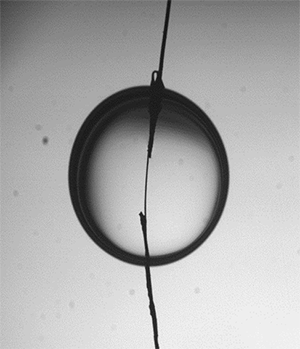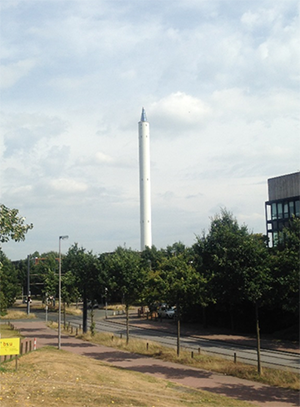HOME > Research Activities > Research Updates >
In the Large Helical Device, in order to generate a magnetic field for confining plasma, using liquid helium we cool the helical coils to a temperature of – 270 degrees Celsius. In a familiar example, superconductor coils are used in MRI devices in hospitals, and these coils, too, are cooled by liquid helium. When the liquid helium reaches the still lower temperature than – 271 degrees Celsius, it becomes superfluid helium. This superfluid helium bears extremely unique properties. Here, we will introduce experimental research regarding superfluid helium.
Superfluid helium has numerous extremely unique properties. First, it has no viscosity. No matter how narrow, superfluid helium will flow smoothly through the tube. Further, because it has the extremely high capability to transport heat, in superfluid helium there is no temperature difference. These two qualities are excellent for cooling the superconducting coils, and ideal cooling can be achieved in which the superfluid helium permeates even into narrow spaces and a uniform temperature is achieved. However, because there are costs in cooling helium to an extreme low temperature, and ingenuities are necessary in the cooling device, in many instances liquid helium is used. In superconducting coils which require extremely high performance, as the last stronghold, superfluid helium appears. For example, in the TORE SUPRA (currently, WEST) plasma experimental device, in France, superfluid helium was used. In the future fusion reactor, too, in order to generate a magnetic field for confining the plasma, as a means for cooling the coils, the use of superfluid helium may become a candidate.
In this way, superfluid helium has most appropriate qualities for cooling. However, it has limitations. Strongly linked to these limitations is the boiling that occurs in superfluid helium. When a portion of the superfluid helium receives strong heat, that portion is heated and boiling occurs, and the ability to transport heat to another place weakens significantly. If a common fluid, when boiling occurs numerous small bubbles appear, and by disturbing the surrounding liquid the ability to transport heat improves. However, such boiling does not occur in the superfluid helium. The boiling in the superfluid helium is such that the surface is covered by the membrane coming from bubbles. That is, because there are layers of gas between the heat generation area and the liquid, the ability to transport heat weakens significantly. Because the use of superfluid helium is limited at the condition in which such boiling occurs, examining that condition will be extremely important research.
Based upon research to date, we have come to understand that there is an extremely close relationship between the boiling in the superfluid helium and the pressure on the heat generation area. To the extent that the heat generation area sinks deeply in the superfluid helium, the pressure rises (when you dive deeply in the water, this is the same as the water pressure upon the body). Even though the depth of the heat generation area changed slightly, there appeared changes in the boiling condition. Thus, in order to investigate the boiling under the limiting condition of reduced pressure, at NIFS, in collaboration together with the High Energy Accelerator Research Organization and Tsukuba University, as well as with Poland’s Wroclaw University of Technology, we conducted experiments under minute pressure. Because the pressure is determined by the weight of the superfluid helium, we can reduce the pressure by reducing the gravity. We realized the minute pressure condition by dropping an object from a high place, but in a short amount of time. We used a tower by which we achieved 4.7 seconds of microgravity conditions, and repeatedly performed the experiment of dropping superfluid helium in which micro-heater (heat source) is installed. While the helium fell, we investigated the boiling caused by using a heater. As a result, we were able to view a beautiful, spherical bubble that had not been observed on the ground. Because this spherical bubble has no gravitational force, it is not buoyant. And it is considered that the bubble has been formed in a place where it was born because the bubble does not rise.
Observing the growth and contraction of the bubbles in detail that were formed under the microgravity condition, it was possible to analyze heat transport on the surface of bubbles. The heat transport on the surface of bubbles is important for determining the quality of boiling. Through such experiments under microgravity and their analyses, effects of gravity and those that could not be seen due to gravity are gradually becoming clear.

Image 1: An image of boiling that appeared while falling. This bubble, which was formed in the superfluid helium, is approximately 5mm in size and it has a beautiful spherical form. The thin line that may be seen at the center is 50 microns in diameter, and its length is approximately 2mm.

Image 2: For experiments in microgravity, the drop tower of Bremen University was used. This tower is most striking in Bremen University, at first glance it resembles a pencil. Weddings may also be held at the top of the tower.
